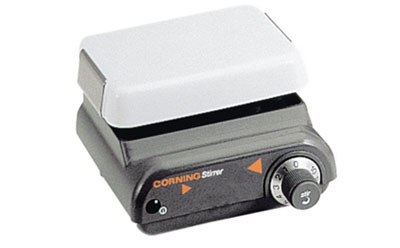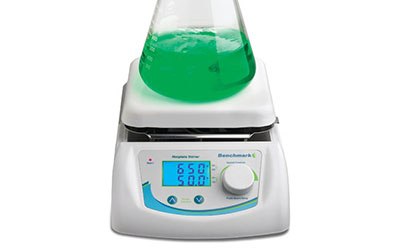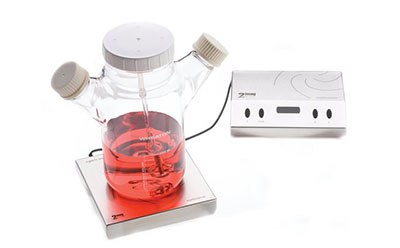Laboratory Stirring & Mixing
Mixing, stirring, and shaking laboratory equipment can be quite specialized so it is important to obtain the correct item for the task. Due to the complexity in mixing, there are numerous different types of laboratory mixers. The simplest is the use of a stir rod or spatula to manually mix solutions. An overhead stirrer and impeller has many advantages with highly viscous samples over a magnetic stirrer, however, a magnetic stirrer is often much cheaper and has the option of including heating within the plate and the advantage of numerous designs of stir bars to produce differing amounts of shear stress. There are also a wide variety of laboratory rockers and rollers with motions on various planes. With their slower speeds and greater control, they are often used in cell and tissue culture work, staining, blotting and sedimentation studies. Vortexers are simple devices used to swiftly mix reagents or suspend cells within a small vial.
Products
Popular Filters
Products
Stir Rods and Spatulas
Stir rods and spatulae are used to mix solutions manually. Stir rods should be selected based on dimensions and material. PTFE and polypropylene stir bars are autoclavable and offer good heat resistance. Polyethylene and steel rods provide both chemical and temperature resistance. Borosilicate glass rods can be used for general purpose stirring or for use with mixtures that are reactive with plastics or steel. Laboratory spatulas are useful for scooping and scraping, and are available with heads in various shapes to accommodate different vessels or samples with varying levels of sedimentation.Mixing is used in research labs and industrial labs for blending, dissolving, or other purposes. A variety of devices are available for stirring and mixing solutions and samples.
Vortexers
Vortex mixers use circular motion to form vortices in liquids and fluids that uniformly mix the solution. Vortexers are available with touch activation or continuous mode operation, fixed and adjustable speeds, and platforms that support different types of vessels and containers ranging from small tubes to large plates. The orbit diameter of the vortexer or orbital shaker determines which vessels can be used. Smaller 3 mm orbits are suited for microplates, microfuge tubes, and other small vessels. Mid-size 15 mm - 25 mm orbits are good for cell culture dishes, flasks, and beakers. Larger orbits (>30 mm) are recommended for large volume or wide vessels.
Magnetic Stir Bars
Magnetic stir bars should be selected based on shape, size, and material.
Shape
The shape of the stir bar can affect degree of agitation and vessel compatibility.
- Round stir bars are typically used with flat-bottom beakers and vessels.
- Slide round stir bars have a pivot ring around the center to reduce vibrations and friction and work well in containers that have curved or uneven bottoms.
- Spherical stir bars are used in tubes and vials.
- Elliptical stir bars are ideal for use in round-bottomed beakers.
- Cross-shaped spin bars stabilize stirring at high speeds and are recommended for turbulent solutions or solutions with sedimentation.
- Crown stir bars are used in cuvettes or test tubes.
- Bone-shaped stir bars are recommended for use in containers with slightly convex bottoms.
- Triangular stir bars are good at scraping and preventing sedimentation and are recommended when increased turbulence is required for mixing.
Size
Stir bars should be small enough so that they do not touch the walls of the vessel during stirring. Maximizing the size of the stir bar enables more motion and better mixing. Curved vessels will require smaller stir bars to prevent snagging on the sides of the flask.
Material
Magnetic stir bars are typically made from alloys of aluminum, nickel, and cobalt. Samarium cobalt stir bars couple more strongly with the internal stir magnet of the plate stirrer or stir mantle. Stir bars are typically coated with PTFE, which has high chemical and temperature resistance. The coating material should be compatible with your sample.
Plate Stirrers and Stir Mantles
Select an effective stirrer or stirring hot plate based on one or two selection criteria, but get the best match for your application by keeping these variables in mind:
Accuracy and stability: Basic analog units are not designed to provide exact control stirring speed, but they do offer economy, reliability, and ease of use when precise control is not required. For applications in which the control of stirring speed is crucial, units with electronic feedback controls offer the greatest degree of accuracy and stability. A microprocessor control monitors stirring speeds and automatically compensates for changes in the system relative to a selected set point. Although more costly, these precise controls can hold a specific stirring speed for more reproducible results.
Volume: Stirrers and stirring hot plates come in many different sizes and configurations from small, single-vessel units to large-capacity, multi-unit ones. Units designed for synchronous stirring and heating of multiple vessels are available with individual stir controls for as many as nine vessels.
Viscosity: All stirrers are not created equally when it comes to magnetic coupling strength. The ability of a drive-magnet and stir-bar pair to effectively stir a given solution is a function of several variables such as drive-magnet shape and size, stir-bar shape and size, the distance between the stir bar and drive magnet, vessel shape and size, desired stir speed, and your solution’s viscosity. Stirring more viscous solutions requires a unit with greater magnetic coupling strength: select a stirrer with a larger drive magnet (>12 cm in length), heavy-duty motor, and the capacity to accommodate longer stir bars.
Conventional motor vs. induction drive: Conventional pull magnet motors have the reputation of being problematic, wear over time causing maintenance needs, and can produce significant heat during log stirring times. Induction drives, as used by 2MAG stirrers, have no moving parts so are wear- and maintenance-free, great for robotics as they are flat and space-saving, ideal for temperature sensitive samples as they produce minimal heat, and are available with remote controllers to increase versatility and enable total submersion.
Rockers and rollers
The vast array of shaking motions available can be confusing but each have their own features. Orbital shaker platforms move in a circular motion ideal for many molecular biology applications and prevent a “skin” formation on the surface of a liquid. Rotating motions gently spin samples in tubes, flask, or bottles. Some also have an adjustable tilt enabling a choice of rotation angle. Their slow and gentle mixing means they are ideally suited for delicate samples. Rocking platforms can provide 2-D or 3-D rocking motion. These also provide gentle, uniform mixing and are typically used with microplates or racks of vials and tubes. They are ideal for immunoassays, blood samples, cell suspensions, and blots. Waving shakers are used for shear sensitive fluids such as ELISA, DNA extraction, protein synthesis and hybridization. Most models have variable speed and tilt angle.
Impellers and Stir Blades
Impellers use shear force, vortex, or aeration to mix samples when combined with compatible shafts or blades. Impellers should be selected based on flow, diameter, viscosity, and material. Axial flow is recommended for liquid blending. Radial flow provides higher shear and turbulence and is recommended for dispersion and emulsion mixing. Tangential flow is recommended for mixing high viscosity samples. Impellers are typically made from different grades of stainless steel or PTFE for applications involving harsh or corrosive samples.
Overhead Stirrers
Overhead stirrers are positioned above the sample and use impellers to mix samples. They should be selected based on stirring speed, volume, torque, and viscosity. Higher torque is recommended for mixing higher viscosity mixtures. Overhead stirrers are available with a variety of options including reversible directional stirring, programming for automatic shutdown, data logging, and overload/overheat protection.
To continue reading please sign in or create an account.
Don't Have An Account?



